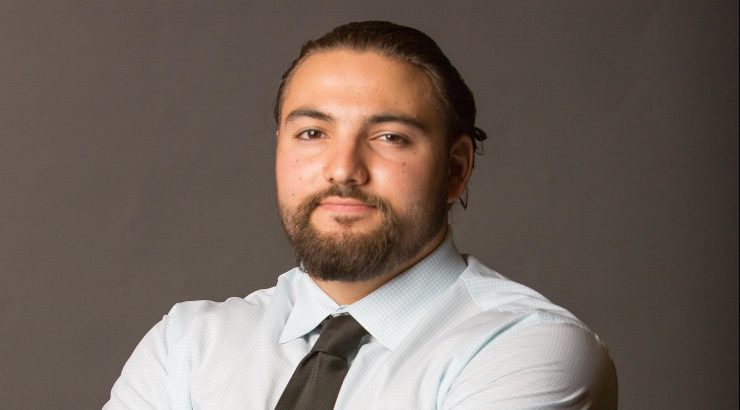Business & Professional Communication The most underrated course in the School of Communication.
November 21, 2018
Christian Mulligan, Diego Velez, and Diano Pachote are Strategic & Corporate Communication majors expected to graduate in the spring of 2018. Diego Velez and Diano Pachote are both members of the School of Communication Student Advisory Board.
Business and Professional Communication offered us an incredible experience revolving around some key concepts we use each and every day. We covered a few verbal strategies, non-verbal strategies as well as how to successfully build our LinkedIn profiles. We will gladly elaborate on these concepts and how we have found them useful!
Business and Professional Communication informed us about some pretty incredible things, but one of the most interesting was certainly the study of verbal strategies. Verbal strategies can be implemented in our daily lives, and we use these methods to help us persuade and change behavior. The first verbal strategy is speaking to show strength. That entails eliminating speech that includes “I think” or “probably” and “its possible” and replacing them with affirmative words. This is incredibly important to help show competence to potential employers and bolster opinions and arguments within friend groups and familial discussions.
The next major verbal strategy revolved around using intense, animated language. It is as obvious as it sounds, but once we became aware of the principle, we are now able to practice it every day! Instead of using plain language that can go unnoticed, we learned to switch to verbiage that demands more attention. An example of plain language would be “Hey Christian, you should buy this vacuum cleaner.” The same example with intense, animated language would read, “Christian! There is this new vacuum that everyone is raving about! You need to come with me to get one now!” These verbal strategies have been critical in furthering our communication skills, but they are complemented by a host of non-verbal strategies as well.
Non-verbal strategies, it can be argued, are more important than verbal strategies. When a presenter walks into the room, the way they walk, how they are dressed, and their facial expression can immediately clue the audience into how the presentation is going to go. Knowing how to control your non-verbal strategies can spell the difference between success and failure.
In Business and Professional Communication, a large portion of the class was dedicated to this subject. While it is somewhat theory-based, non-verbal strategies can also seem like simple common sense. There are aspects of the subject, however, that will completely change your presentation
Firstly, kinesics, or body language, can be used to show power, confidence, and intelligence; however, some unintentional habits, like fidgeting, looking down, slouching, and tapping your feet, can show nervousness, low confidence, and unpreparedness.
Next, chronemics, or themes related to time, has several meanings, customs, and attitudes. Things like “wait a minute”, or “just a second”, are abstract and ambiguous, and do not necessarily mean what is specifically said. However, “arrive in one hour”, carries more concrete meaning. Customs of chronemics include things like the work day beginning at 9am and ending at 5pm, or lunch begins at 12 noon and ends at 1pm. Finally, there are attitudes associated with time, like “time is money”, and “quality over quantity”. Time is some people and organizations most treasured commodity, and attitudes toward it can change some perspectives on how it should be used.
The third most important non-verbal strategy is Proxemics. This is the concept of distance from your audience, and how you use your space that you have. For example, a presenter may use territoriality to claim their space in a room. They may choose just the front, or they may use all the aisles, rows, and walkways, and use the entire space to their advantage. Also, each presenter differs on how much distance they like to keep between themselves and their audience. Some like to get up-close and personal; others like to keep a larger space between. It is mostly preference based, and both can be used successfully if done right.
Finally, we have LinkedIn. One of the biggest takeaways from this class was that we learned how to build a strong, professional LinkedIn profile. Business and Professional Communication required us to create a LinkedIn and fulfill certain requirements. Since we were continually working on our LinkedIn we got the opportunity to form close relationship the Career and Professional Development Center. With the help of experts in the Career and Professional Development Center, we were able to create top of the line LinkedIn profiles. Through these profiles, many of us have been contacted by recruiters. Most of these messages resulted in interviews with that company. With the interview skills that we were taught in this class, many of us were able to turn these interviews into job or internship offers. It is amazing how so much could stem from one class.
In conclusion, we were able to take away a handful of skills from Business and Professional Communication. Verbal strategies taught us how to speak to show strength while using intense animated language. The Nonverbal communication skills we learned has taught how to present ourselves. While the strategies on LinkedIn has helped us get jobs and internships. Business and Professional Communication had been a huge benefit to our everyday lives!


